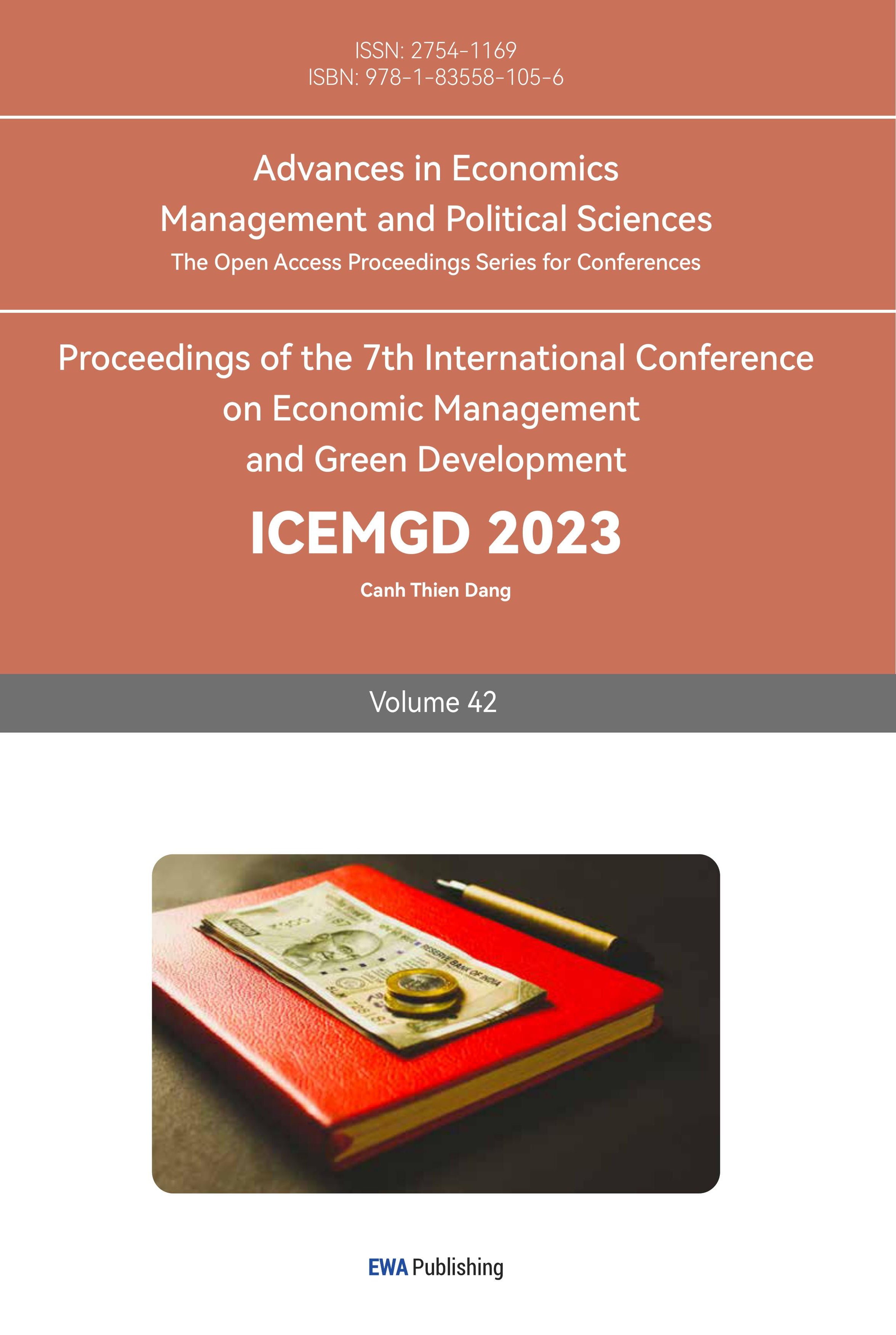References
[1]. Gjini, V., & Koprencka, L. (2018). Relationship Between Economic Factors and Non- Performing Loans- the Case of Albania. European Journal of Economics and Business Studies, 10(1), 253.
[2]. Louzada, F., Ara, A., & Fernandes, G. B. (2016). Classification methods applied to credit scoring: Systematic review and overall comparison. Surveys in Operations Research and Management Science, 21(2), 117–134.
[3]. Ripley, B. D. (1996). Pattern Recognition and Neural Networks. Cambridge University Press.
[4]. Feng, L., Yao, Y., & Jin, B. (2010). Research on Credit Scoring Model with SVM for Network Management. ResearchGate. https://www.researchgate.net/publication/268266895_Research_on_Credit_Scoring_Model_with_SVM_for_Network_Management
[5]. Berkson, J. (1944). Application of the Logistic Function to Bio-Assay. Journal of the American Statistical Association, 39(227), 357–365.
[6]. Dik, V. V. (2014). Decision support methods in balanced scorecard. Naukovyi Visnyk Natsionalnoho Hirnychoho Universytetu, 4, 120–126.
[7]. Banasik, J., Crook, J., & Thomas, L. (2003). Sample Selection Bias in Credit Scoring Models. The Journal of the Operational Research Society, 54(8), 822–832.
[8]. Traczynski, J. (2017). Firm Default Prediction: A Bayesian Model-Averaging Approach. Journal of Financial and Quantitative Analysis, 52(3), 1211–1245.
[9]. Bücker, M., Szepannek, G., Gosiewska, A., & Biecek, P. (2021). Transparency, auditability, and explainability of machine learning models in credit scoring. Journal of the Operational Research Society, 73(1), 70–90.
[10]. Siddiqi, N. (2005). Credit Risk Scorecards: Developing and Implementing Intelligent Credit Scoring. http://ci.nii.ac.jp/ncid/BA75777283
[11]. Setting Options for the Binning Node. (n.d.). IBM SPSS modeler help. Retrieved June 23. 2023 from http://127.0.0.1:50727/help/index.jsp?topic=/com.ibm.spss.modeler.help/clementine/binning_settingstab.htm.
[12]. Eeckhoudt, L., & Godfroid, P. (2000). Risk Aversion and the Value of Information. Journal of Economic Education, 31(4), 382–388. https://doi.org/10.1080/00220480009596456
[13]. Dastile, X., Celik, T., & Potsane, M. M. (2020). Statistical and machine learning models in credit scoring: A systematic literature survey. Applied Soft Computing, 91, 106263.
[14]. Zeng, G. (2013). Metric Divergence Measures and Information Value in Credit Scoring. Journal of Mathematics, 2013, 1–10.
[15]. Mize, T. D., Doan, L., & Long, J. S. (2019). A General Framework for Comparing Predictions and Marginal Effects across Models. Sociological Methodology, 49(1), 152–189.
[16]. Nguyen Viet, C. (2007). The average treatment effect and average partial effect in nonlinear models. Mpra.ub.uni-Muenchen.de. https://mpra.ub.uni-muenchen.de/44483/
Cite this article
Xiao,Y. (2023). The Predictive Power of Credit Scores: Examining Default Probability in Taiwanese Credit Card Clients. Advances in Economics, Management and Political Sciences,42,139-147.
Data availability
The datasets used and/or analyzed during the current study will be available from the authors upon reasonable request.
Disclaimer/Publisher's Note
The statements, opinions and data contained in all publications are solely those of the individual author(s) and contributor(s) and not of EWA Publishing and/or the editor(s). EWA Publishing and/or the editor(s) disclaim responsibility for any injury to people or property resulting from any ideas, methods, instructions or products referred to in the content.
About volume
Volume title: Proceedings of the 7th International Conference on Economic Management and Green Development
© 2024 by the author(s). Licensee EWA Publishing, Oxford, UK. This article is an open access article distributed under the terms and
conditions of the Creative Commons Attribution (CC BY) license. Authors who
publish this series agree to the following terms:
1. Authors retain copyright and grant the series right of first publication with the work simultaneously licensed under a Creative Commons
Attribution License that allows others to share the work with an acknowledgment of the work's authorship and initial publication in this
series.
2. Authors are able to enter into separate, additional contractual arrangements for the non-exclusive distribution of the series's published
version of the work (e.g., post it to an institutional repository or publish it in a book), with an acknowledgment of its initial
publication in this series.
3. Authors are permitted and encouraged to post their work online (e.g., in institutional repositories or on their website) prior to and
during the submission process, as it can lead to productive exchanges, as well as earlier and greater citation of published work (See
Open access policy for details).
References
[1]. Gjini, V., & Koprencka, L. (2018). Relationship Between Economic Factors and Non- Performing Loans- the Case of Albania. European Journal of Economics and Business Studies, 10(1), 253.
[2]. Louzada, F., Ara, A., & Fernandes, G. B. (2016). Classification methods applied to credit scoring: Systematic review and overall comparison. Surveys in Operations Research and Management Science, 21(2), 117–134.
[3]. Ripley, B. D. (1996). Pattern Recognition and Neural Networks. Cambridge University Press.
[4]. Feng, L., Yao, Y., & Jin, B. (2010). Research on Credit Scoring Model with SVM for Network Management. ResearchGate. https://www.researchgate.net/publication/268266895_Research_on_Credit_Scoring_Model_with_SVM_for_Network_Management
[5]. Berkson, J. (1944). Application of the Logistic Function to Bio-Assay. Journal of the American Statistical Association, 39(227), 357–365.
[6]. Dik, V. V. (2014). Decision support methods in balanced scorecard. Naukovyi Visnyk Natsionalnoho Hirnychoho Universytetu, 4, 120–126.
[7]. Banasik, J., Crook, J., & Thomas, L. (2003). Sample Selection Bias in Credit Scoring Models. The Journal of the Operational Research Society, 54(8), 822–832.
[8]. Traczynski, J. (2017). Firm Default Prediction: A Bayesian Model-Averaging Approach. Journal of Financial and Quantitative Analysis, 52(3), 1211–1245.
[9]. Bücker, M., Szepannek, G., Gosiewska, A., & Biecek, P. (2021). Transparency, auditability, and explainability of machine learning models in credit scoring. Journal of the Operational Research Society, 73(1), 70–90.
[10]. Siddiqi, N. (2005). Credit Risk Scorecards: Developing and Implementing Intelligent Credit Scoring. http://ci.nii.ac.jp/ncid/BA75777283
[11]. Setting Options for the Binning Node. (n.d.). IBM SPSS modeler help. Retrieved June 23. 2023 from http://127.0.0.1:50727/help/index.jsp?topic=/com.ibm.spss.modeler.help/clementine/binning_settingstab.htm.
[12]. Eeckhoudt, L., & Godfroid, P. (2000). Risk Aversion and the Value of Information. Journal of Economic Education, 31(4), 382–388. https://doi.org/10.1080/00220480009596456
[13]. Dastile, X., Celik, T., & Potsane, M. M. (2020). Statistical and machine learning models in credit scoring: A systematic literature survey. Applied Soft Computing, 91, 106263.
[14]. Zeng, G. (2013). Metric Divergence Measures and Information Value in Credit Scoring. Journal of Mathematics, 2013, 1–10.
[15]. Mize, T. D., Doan, L., & Long, J. S. (2019). A General Framework for Comparing Predictions and Marginal Effects across Models. Sociological Methodology, 49(1), 152–189.
[16]. Nguyen Viet, C. (2007). The average treatment effect and average partial effect in nonlinear models. Mpra.ub.uni-Muenchen.de. https://mpra.ub.uni-muenchen.de/44483/









